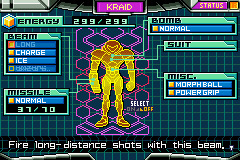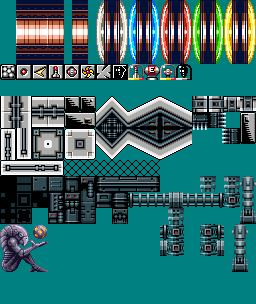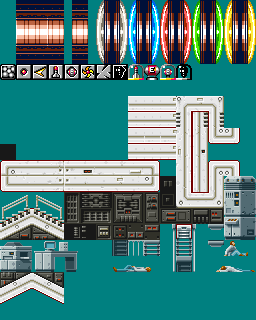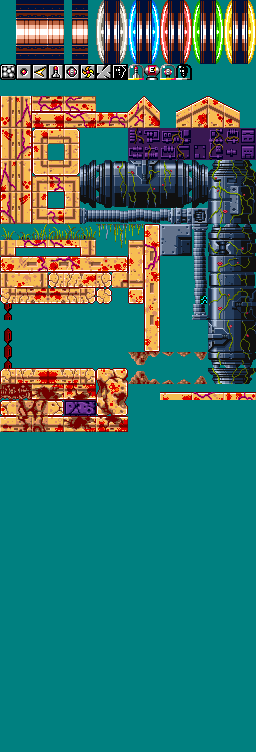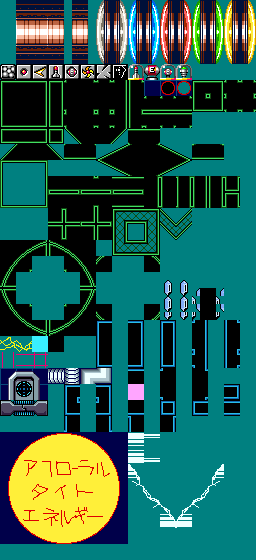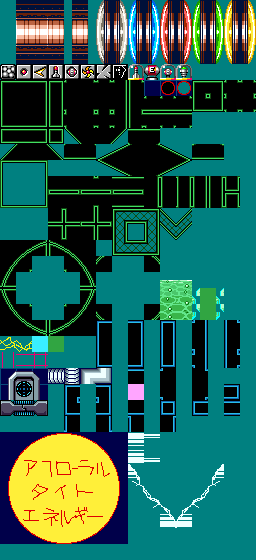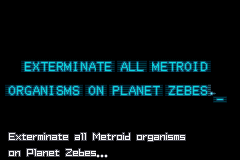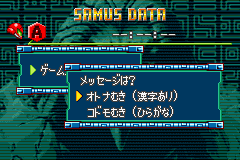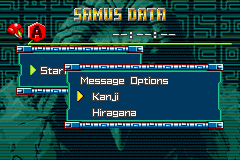Metroid Zero Mission
| Metroid Zero Mission |
|---|
|
Also known as: Miteluode: Lingdian Renwu (CN)
|
Metroid Zero Mission is Samus' first mission, retold in a Super Metroid style with 80% more anime.
Contents
Sub-Page
| Prototype Info |
Unused Feature
The ability to toggle upgrades on and off, just like in Super Metroid. It may have been used for debugging purposes, however, prototypes of Zero Mission have an accessible debug menu on the status screen in a similar fashion to Metroid Fusion. From the debug menu, any ability can be toggled on or off, regardless if you have collected it.
While you can toggle abilities with this Super Metroid-like feature, you can only do so once you find the ability. Having a second, separate method, to toggle equipment on or off just for debugging purposes is redundant and lends credibility to the idea that the developers intended for the player to toggle their upgrades like in Super Metroid. The most likely reason why this feature was dropped was because there isn't a real reason to allow the player to toggle abilities on and off. In Super Metroid, you could toggle abilities to create special beam combos, but this feature doesn't exist in Metroid Zero Mission.
You can enable this feature with the CodeBreaker code 730016C4 0080 83000BF0 0006. This function only allows toggling beam upgrades and upgrades in the Miscellaneous category. A ROM hack was created to allow toggling any upgrade.
Testing Rooms
A bit different from the ones in Metroid Fusion. The jewels from Wario Land 4 are used as a water effect layer in one room.
Unused Graphics
![]()
The graphics used by the disabled item switch feature.
![]()
Placeholder graphics for the expansion items that get replaced with animated versions.

The graphics data for the Metroids has a scratch area, showing how it should look assembled. There is also a useful number guide for the electrical effect's animation order.
![]()
The graphics for Zero Suit Samus' auto-charging stun gun has a placeholder graphic for the Charge Meter that appears in the HUD. The meter graphics are dynamically loaded from ROM.
![]()
Present in both Fusion and Zero Mission, there exist in the font graphics unused L and R button icons, and several different versions of the capital X character.
![]()
Also present in both games is this placeholder graphic. The text, "「マップ」", translates to "Map".
Plasma Beam without Ice Beam
Much like other Metroid games since Metroid II: Return of Samus, this game features the powerful Plasma Beam, first obtained as an unusable Unknown Item that later gets activated after defeating the Ruins Test. However, as the Ice Beam is required to defeat the Metroids in Tourian and gain access to Chozodia (and in turn the Ruins Test) and the Item Switch feature was disabled, it is impossible to have the Plasma Beam equipped without the Ice Beam, which has a unique light green/teal-ish palette, as well as unique sounds for being combined with other beams.
Unused Tilesets
Tileset ID: 00
This the tileset used in the inaccessible debug rooms, and is the only unused tileset that is actually used in a real room. It contains the same Wario Land 4 blocks as Fusion's debug tileset uses, and has a similar layout, albeit most of the tiles were redrawn. It also contains crude placeholders for the Missile, Energy Tank and Power Bomb pickups, though interestingly not for Super Missiles.
Tileset ID: 04
An unused tileset with a style very reminiscent of the first rooms in Fusion's sectors, though the tiles aren't exactly the same. It notably features ladders (Which aren't used in Zero Mission) and a tile-based Chozo statue identical to its appearance as the form the Charge Beam Core-X takes. Zero Mission's Chozo Statues are much bigger and are entirely sprite-based. Perhaps they were meant at first to be tile-based like previous games?
Tileset ID: 05
This unused tileset is almost identical to Fusion's Tileset ID 12, just with the yellowish tiles' color being changed to white. Interestingly, the rooms this tileset is used for in Fusion use what would become Zero Mission's debug room background.
Tileset ID: 0A
Another Fusion leftover, this one is an edited copy of Fusion's Tileset ID 1F, though lacking the destroyed hatch, with the brown pipes being recolored to a dark metallic blue and the main grey tiles being recolored to be...Flesh-colored with blood stains?
It is unknown if these Fusion tilesets were ever meant to be used in the final game, or were just placeholders and/or leftovers.
Tileset ID: 1C
This is probably the most interesting out of the unused tilesets, and is completely original. This seems to be a debug tileset, although it is never used in any of the game's various debug rooms. It has a lot more different tiles than the used debug room tileset, such as some for testing out vents. There are also some stranger tiles at the bottom, various red lines, what seems to be an outline for lava or electricity, a futuristic-looking door, some metallic pipe tiles and what seems to be tiles for testing out the breakable tube in Chozodia.
There is also the Japanese message in the circle that says "Afloraltite Energy". Afloraltite was mentioned in the Metroid manga as being a fuel for spaceships, being mined on K-2L, Samus's home planet. Perhaps this tileset was once used as a placeholder in the Space Pirate Mothership?
Tileset ID: 2B
There also exists another variant of this tileset, with the only difference being the presence of acid tiles.
Unused Sprites
Screw Attack Hint Chozo
Unused sprite 2E is a Chozo hint statue meant for helping the player find the Screw Attack. There are other similar statues in the game to help the player find other upgrades. However, in the final game the one for the Screw Attack was replaced with a useless destroyed variant, leaving it up to the player to locate the Screw Attack. Its sprite is still loaded in the spriteset for that room, and can easily be added back. Its hint path was never properly coded, however, hinting that it was likely scrapped pretty early. There exist no similar hint Chozos for the Unknown Items.
Crocomire
Crocomire, a miniboss from Super Metroid, was set to appear in Zero Mission! It is still in the game as sprite 8A, and unused event flag 40 (Labelled CROCOSI in the Debug build's event viewer) is there to track if it's dead or not. Much of its coding is incomplete/broken however, and as such all it does it stay in place and move its mouth a bit. It can be damaged with Charge Beam and missiles, however all that depleting its health does is remove its hitbox.
Geki Tai Machine
Sprite 6C seems to be a leftover from a scrapped boss concept, the Geki Tai (Repel/Boss Joint) Machine. It is referenced by unused event flag 41 (Labelled GEKITAIM in the Debug build's event viewer) which would have been used for it being dead, though unlike Crocomire, it has no remaining code or animations.
Unused Track
A leftover track from Fusion, which was used in that game's opening. It is still programmed to play after the opening track, however the title screen appears before it has the chance to do so.
Intro Subtitles
The large intro text is always English. Accordingly, its English subtitles went unused. They can be seen with CodeBreaker code 33000020 0003.
Regional Differences
Title Screen
| US | Europe | Japan | China |
|---|---|---|---|
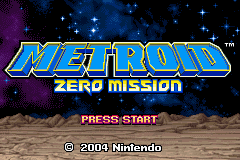
|
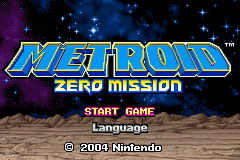
|
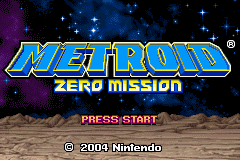
|
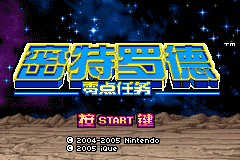
|
The European version changed "Press Start" to "Start Game" and added a language option. The Japanese version replaced the ™ with an ®.
Text Option
As in Metroid Fusion, the Japanese version has an option to switch the text between "オトナむき(漢字あり)" (For Adults (with Kanji)) and "コドモむき(ひらがな)" (For Kids (Hiragana)).
Languages
Similar to Metroid Fusion, all versions of the game have English and Japanese with and without kanji, and the European version adds the other European languages. The US edition doesn't expose any of these languages except English, the Japanese version only exposes the two Japanese language settings, and the European version doesn't expose the Japanese language options. You can access different languages by changing the value at 0x03000020.
In the European and US versions, pushing Start at the title screen after forcing the language to Japanese will crash the game.
Language Values:
| Language | Hex Value |
|---|---|
| Japanese with kanji | 0x0 |
| Japanese without kanji | 0x1 |
| English | 0x2 |
| German | 0x3 |
| French | 0x4 |
| Italian | 0x5 |
| Spanish | 0x6 |
Strangely enough, the menu that normally allows you to switch between Japanese with kanji and Japanese without kanji has an English translation in the Japanese version.
File Select
| US/Europe | Japan | China |
|---|---|---|
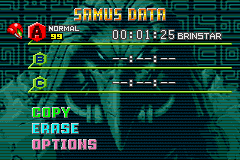
|
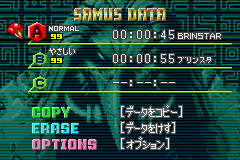
|
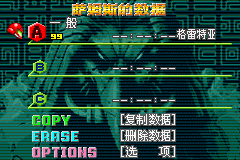
|
The Japanese and Chinese versions include translations of COPY, ERASE, and OPTIONS.
Space Pirate Mothership
| This page or section needs more images. There's a whole lotta words here, but not enough pictures. Please fix this. |
- In the US and Japanese versions, two Missile Blocks in the Space Pirate Mothership come back after you destroy them. This means that you must be able to carry at least three Missiles (so two Missile Tanks on Hard Mode) in order to complete the game (there is a Missile Door later that you must pass through before you are able to refill your ammo at a Save Station).
- In the European version, these blocks do not come back once destroyed. After you destroy them, you can return to the previous Save Point, refill your ammo, and complete the game. Thus, you only need one Missile Tank (two Missiles) for Hard Mode in the European version, making the lowest possible item collection rate 9% for both Normal Mode and Hard Mode in the European version (versus 10% for Hard Mode in the American and Japanese versions).
The Metroid series
| |
|---|---|
| NES | Metroid |
| Game Boy | Metroid II: Return of Samus |
| SNES | Super Metroid |
| Game Boy Advance | Metroid Fusion (Prototype) • Metroid Zero Mission (iQue Prototype) |
| Wii | Metroid: Other M |
| Nintendo 3DS | Metroid: Samus Returns |
| Nintendo Switch | Metroid Dread |
| Metroid Prime | |
| GameCube | Metroid Prime (Prototype) • 2: Echoes (Prototype) |
| Nintendo DS | Pinball • Hunters (First Hunt Prototype) |
| Wii | 3: Corruption (Prototype) Metroid Prime (Wii de Asobu) • 2: Dark Echoes (Wii de Asobu) |
| Nintendo 3DS | Federation Force (Blast Ball) |
- Pages missing developer references
- Games developed by Nintendo R&D1
- Pages missing publisher references
- Games published by Nintendo
- Games published by iQue
- Game Boy Advance games
- Pages missing date references
- Games released in 2004
- Games released in May
- Games released on May 27
- Games released in February
- Games released on February 9
- Games released in April
- Games released on April 8
- Games released in March
- Games released on March 19
- Games with unused areas
- Games with unused enemies
- Games with unused graphics
- Games with unused abilities
- Games with unused music
- Games with unused text
- Games with debugging functions
- Games with regional differences
- Pages with a Data Crystal link
- Needs more images
- Metroid series
Cleanup > Needs more images
Cleanup > Pages missing date references
Cleanup > Pages missing developer references
Cleanup > Pages missing publisher references
Games > Games by content > Games with debugging functions
Games > Games by content > Games with regional differences
Games > Games by content > Games with unused abilities
Games > Games by content > Games with unused areas
Games > Games by content > Games with unused enemies
Games > Games by content > Games with unused graphics
Games > Games by content > Games with unused music
Games > Games by content > Games with unused text
Games > Games by content > Pages with a Data Crystal link
Games > Games by developer > Games developed by Nintendo > Games developed by Nintendo EPD > Games developed by Nintendo SPD > Games developed by Nintendo R&D1
Games > Games by platform > Game Boy Advance games
Games > Games by publisher > Games published by Nintendo
Games > Games by publisher > Games published by Nintendo > Games published by iQue
Games > Games by release date > Games released in 2004
Games > Games by release date > Games released in April
Games > Games by release date > Games released in April > Games released on April 8
Games > Games by release date > Games released in February
Games > Games by release date > Games released in February > Games released on February 9
Games > Games by release date > Games released in March
Games > Games by release date > Games released in March > Games released on March 19
Games > Games by release date > Games released in May
Games > Games by release date > Games released in May > Games released on May 27
Games > Games by series > Metroid series
